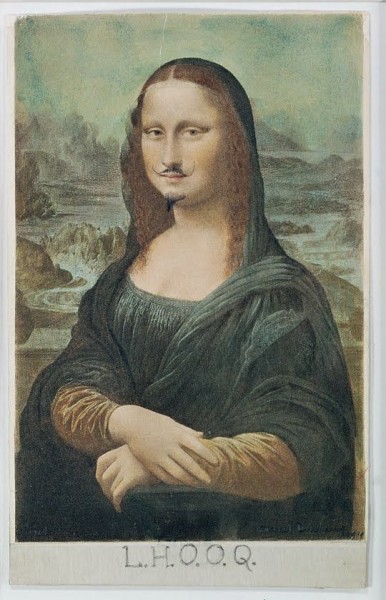 Marcel Duchamp, L. H. O. O. Q., 1919, pen on a postcard, 19.7 x 12.4 cm, Philadelphia Museum of Art, Philadelphia, artwork in the Public Domain.
Marcel Duchamp, L. H. O. O. Q., 1919, pen on a postcard, 19.7 x 12.4 cm, Philadelphia Museum of Art, Philadelphia, artwork in the Public Domain.
Dada is an art movement that originated in the early 20th century in response to World War I, after which the artists and writers in this group felt society was morally bankrupt. The word, “Dada,” was picked randomly from a French-German dictionary and reflects the intentionally nonsensical, yet iconoclastic activities of the art movement. One of the group’s main intentions was to ridicule the bourgeois values that society held in high regard, such as nationalism and technology, that the artists believed ultimately led to the war and all of its carnage and destruction.
Dada was a group of many people, but a leader within was Marcel Duchamp, who introduced the readymade to the world, and thus initiated conceptual art in which an idea is more important than aesthetics.
Duchamp’s L.H.O.O.Q. (1919) is an excellent example of conceptual art because the concept is more important than the object. It is a postcard of Leonardo’s Mona Lisa onto which Duchamp drew a beard and mustache and wrote, “L.H.O.O.Q.,” an acronym for the French phrase, “She has a hot ass.” He was ridiculing bourgeois values by vandalizing an “important” work of art; yet, in his typical humorous fashion, the act itself is absurd, as he really vandalized a postcard and drew attention – in a rather vulgar way – to a part of Mona Lisa that no one has ever seen.
 Marcel Duchamp, L. H. O. O. Q., 1919, pen on a postcard, 19.7 x 12.4 cm, Philadelphia Museum of Art, Philadelphia, artwork in the Public Domain.
Marcel Duchamp, L. H. O. O. Q., 1919, pen on a postcard, 19.7 x 12.4 cm, Philadelphia Museum of Art, Philadelphia, artwork in the Public Domain.
 Marcel Duchamp, L. H. O. O. Q., 1919, pen on a postcard, 19.7 x 12.4 cm, Philadelphia Museum of Art, Philadelphia, artwork in the Public Domain.
Marcel Duchamp, L. H. O. O. Q., 1919, pen on a postcard, 19.7 x 12.4 cm, Philadelphia Museum of Art, Philadelphia, artwork in the Public Domain.

